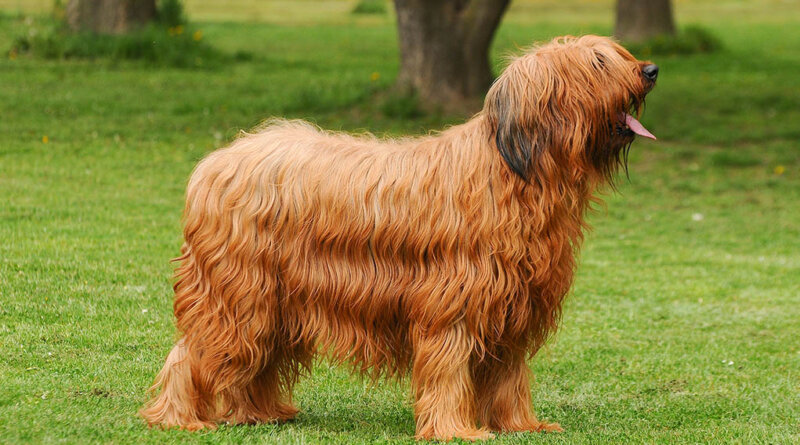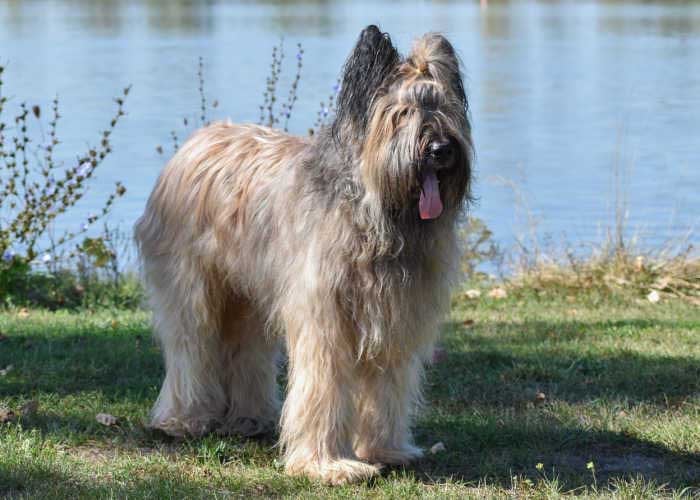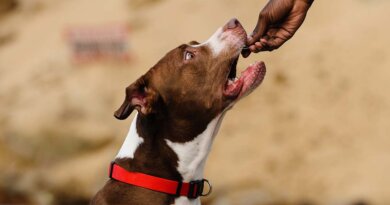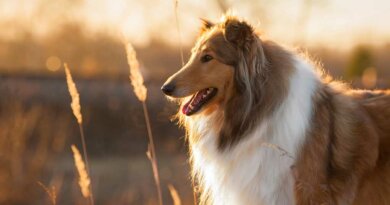Briard Dog Breed Profile – Top Dog Tips
This irresistible puppy that looks rather shaggy but handsome is the Briard dog breed.
With great agility, herding, and safeguarding skills, the Briard breed isn’t just your lush, full beautiful dog!
The Briard is a large breed of dog that originated in France. They are known for their distinctive shaggy coat.
Originally bred to be herding dogs, Briards can also be used as guard dogs, search and rescue dogs, and companions.
Briards are known for their intelligence, loyalty, and protective nature. They are highly trainable and respond well to positive reinforcement.
If you’re looking to adopt a Briard puppy, remember that they require lots of exercise and mental stimulation and thrive when given a job.
They are also known for being great with children and making wonderful family pets.
This blog will discuss everything you need about the Briard dog breed. Let’s dive in and tackle the breed’s history and origin without further ado.
Briard Dog Breed History
The Briard or Chien Berger de Brie originated in France. The Briard is a known as French working dog.
This breed often is utilized for herding and protecting the herd from predators and poachers.
During World War I, the Briard dog was known to be beside soldiers to locate and rescue survivors, doing sentry and delivering supplies.
Despite facing danger and endangerment, this dog breed aids diligently in the war.
This dog was brought to the United States in the early 18th century by the 3rd US President, Thomas Jefferson.
After the war, breeders reestablished the breed with the Beaucerona and Barbet breeds to refine our Briard breed.
Briard Physical Traits
They may look shaggy but with a mix of good looking!
The male Briard dogs can stand up to 23-27 inches weighing 55-100 pounds. In comparison, the female Briard dog breed can stand up to 22-25 ½ inches weighing 55-90 pounds.
The Briard breed may look shaggy, but its coat is lush and full when given the right amount of grooming attention and care.
They also have a long double coat with a finer outer layer and a thicker and coarser inner layer.
The breed can be found in Black, Gray, and Tawny colors. Usually, they can be found in more varied colors but not white.
This breed usually has a darker coat during their first 2- 3 years of age and will gradually become lighter as they age.
The Briard breed leaves a long expression, literally. Their face to their muzzles shape, their body and legs are visually long.
The eyes are large with a narrow and soft look. The Briard’s eyes are usually dark in color, either black or brown.
They are also known for their gorgeous brow hair. Their brows are long and fall on the sides of their face.
The Briard’s ears have distinct high placement on their head, which drops down towards their side to their face. Their nose is often large and black as well.
The Briard breed has a crocheted tail that looks like a unique J-shaped Tail that they develop until 6-8 months.
The dog breed also has long, skinny, muscular fore and back legs. The Briard’s nails are also double rear dew claws.
This helps them through their agility and motion activities, allowing them to drift much easier and faster, especially on earthy grounds.
The Temperament of the Briard Dog
The Briard breed may look playful with its shaggy-looking coat, but they’re quite stern and preservative, especially regarding security.
These dogs are affectionate with its family. The Briard breed will do well with big families and a home where a person is always settled.
Briard dogs are very protective when it comes to their home and family. They may seem unwelcoming, but it’s just one way to say they love and care for their family. This can be adjusted with early socialization and training.
The dog breed is an outdoor kind of fur buddy. They may run to the best home with a big yard or near an open field.
If they can get daily exercise and mental stimulation, apartment-type homes will do okay.
The Briard breed does well with cooler to cold weather, but they may be prone to overheating, especially in the peak of summer.
Make sure to keep them cool enough and hydrated during these seasons.
The breed needs attention, meaning they can not be left alone for more than a few hours. This breed isn’t only intelligent, but they get bored and easily curious easily.
If left alone for more than a few hours, your Briard dog may surprise you with messy decorations at home.
Living with a Briard
The Briard breed is fine with children, but you should always provide supervision.
They may tolerate the commotion and chaos, but they may tend to herd children if they step away from what the dog deems as their home or territory.
The Briard breed prioritizes the safety of their home quite well, so they may display vigilance with unfamiliar people.
This breed will do okay with other dogs, but they may need time and gradual adjustment before doing so.
For both situations, as long as the dog breed is socialized and exposed early, they may become easier and more comfortable opening up to strangers or other dogs.
Training
The Briard dog breed is highly intelligent and driven. They will need plenty of quality training and exercise to help them be physically and mentally stimulated.
The Briard breed is quick to learn and adapt, thus making training and exercise tricky for owners.
The best way to introduce training and exercise for the Briard breed is introducing it to them while they’re young. This can help them absorb and replenish information much easier.
Their history of herding and protecting may have been toned down, but their independence and stubbornness were not so.
Since Briard quickly catches on and learns, training wouldn’t be a problem. Provide varied training sessions to help them be the best boy they can be.
Owners may change training methods from time to time so their Briard gets to be challenged and interested. Owners may use obedience, agility, and problem-solving training methods.
The Briard dog breed is persistent and stubborn and requires continuous training.
Early and continuous socialization with other dogs and people is necessary for this breed. Socializing our Briard breed will help them understand social cues and manners.
The most important thing to consider when training the Briard dog breed is keeping it positive and engaging as much as possible.
Although it may become difficult sometimes, patience with your Briard will bring great results.
Exercise
The Briard breed is quite energetic and creative. The Briard should be exercised daily.
The owners may walk them outside for half an hour. They are also great at running, catching, hiking, and jogging.
Do take note that they shouldn’t overdo their strenuous activities as well. This can be done to vary their exercise regimens.
Remember, this breed is quite independent and great at solving their dilemmas and working. So as much as possible, make them feel they can depend on you!
Health Care of a Briard
The Briard breed can live up to 12 years of age. Although this breed has impressive athleticism, some Briard dogs inherited some diseases due to not undergoing screening before breeding the dog.
Owners should watch out for these diseases and address them accordingly.
Bloat (Gastric Dilation Volvulus)
Gastric Torsion or Bloat is a gastrointestinal condition where-in a dog’s stomach expands due to it teeming with fluid, food, or gas. This can be a fatal circumstance if left untreated.
In some cases, due to bloating, blood is trapped in the stomach preventing return and proper flow.
Prevention includes avoiding your dog from doing activities right after a meal, eating too fast, eating large meals throughout the day, and stressing them.
Treatment may depend on your veterinarian’s observation.
Cancer
Lymphoma is cancer from lymphocytes. This type of cancer often stems from bone marrow, lymph nodes, and spleen.
Although researchers are still looking for the cause, it is suspected that lymphoma is acquired through radiation exposure, chemicals, and more.
Unfortunately, Briard breeds are prone to lymphoma or lymphosarcoma cancer. It’s best to have your Briard dog checked regularly.
Cataracts
A cataract is an obstruction of lens fibre in the lens of an eye. The gradual clouding of the lens in the eyes.
Although this is more common in elderly dogs, it can also be acquired through genetics, traumatic eye injuries, nutritional deficiencies, or diabetes.
Have your pet undergo an ophthalmic examination to detect small cataracts as early as four to five.
To determine whether it is blinding, it is better to check with your veterinarian to be informed what procedure should be done.
Exocrine Pancreatic Insufficiency
Exocrine pancreatic insufficiency is the pancreatic’s dysfunction to create digestive enzymes. This can result in difficulty in digestion to gradual malnutrition.
Exocrine pancreatic insufficiency is often congenital, but it can also be acquired from inflammation, infections, to physical trauma.
Exocrine pancreatic insufficiency treatment may compose of a specified diet and medication.
Hip Dysplasia
Hip dysplasia is a genetic condition wherein the socket of the joint and ball becomes distorted.
When diagnosed with hip dysplasia, it’s essential to keep their weight within the normal range and have them exercise with activities that promote joint therapy.
Veterinarians may prescribe medications for anti-inflammatory or pain relievers and supplements.
Hypothyroidism
Hypothyroidism is the inactive function of the thyroid gland. Metabolism is slowed down if diagnosed.
The immune system attacks the thyroid gland as it does not recognize it. Usually, this is an inherited disorder.
If the Briard dog is experiencing lethargy, slow heart rate, weight gain, excessive shedding, and high cholesterol, it’s best to have them tested by the veterinarian.
If the dog is diagnosed with hypothyroidism, the veterinarian may provide maintenance and recommended diet. It’s best to have this condition checked and addressed immediately.
Diet Needs
Owners may give their Briard dog high-quality dog food and ask their veterinarian if their Briard has some allergies.
Briard dogs may also have varied diets like meat, vegetables, etc. Owners may interchange their diet to promote their appetite.
Briard dogs can have as much as 3-4 cups of high-quality food divided into three a day, but Briard should consume food equal to their activity level.
It’s best to give Briard dogs more if they’re more active.
Briard dogs may have a varied diet, which should be adequate for their age. It’s important not to overfeed them as obesity may cause strain to their joints.
Owners should inquire with their veterinarian regarding human or dog food ingredients that may cause allergies.
Do not forget to get them clean and fresh water accessible at all times. This dog is a very active breed and may need to hydrate themselves often, especially after an extraneous activity.
The Briard breed may have numerous diseases they are prone. That’s why careful screening and attention to their health shouldn’t be overlooked.
Owners must also be responsible for not having their dogs bred if any diseases are acquired.
Grooming
The Briard dog breed has a double type of coat which means they have a finer outer coat and a coarse and short outer coat.
This type of coat helps keep their coat almost grime free. But to keep their coat healthy, the Briard breed may need attention in caring for their fur.
Although this breed has a low level of shedding, they still require great care in grooming their fur. This breed will require some daily brushing.
To maintain its coat health, brushing daily, especially in warmer seasons, is a must.
Since their coat will welcome warmer seasons, they will shed their fur to coordinate with the temperature.
The Briard breed must also bathe at least once or twice a month and after water activities.
If owners cannot attend to the grooming needs of the Briard dog, it’s always a great idea to schedule them with professional groomers.
Owners may also ask their professional groomers to remove matting, especially below their armpits, buttocks, and legs.
The Briard dog should also have their ears cleaned regularly, especially after their bath. Their ears should be patted dry.
As Briard breeds have hair along their pina, accumulation of moisture and grime may lead to infection. Owners may have the hair in the pinna trimmed as well.
Briard dogs should also have their teeth cleaned at least thrice a week or more. Owners may switch to dental treats if they cannot brush frequently.
They can also schedule an annual dental cleaning for their Briard dog.
This breed’s nails are much bigger and sharper. It is important to have their nails trimmed or filed at least weekly or once every two weeks. Owners do not need to trim it if it is not that long.
Frequently Asked Questions about Briards
What type of breed is a Briard dog?
The Briard dog breed is categorized as a medium-large breed dog. They are also part of the utility or working dogs, specifically the herding group.
How much litter can a Briard dog breed have?
The Briard dog breed can have from 6-8 litters. Some even have up to 10 pups.
Are Briard dog ears cropped?
Briard ears may be left naturally flopping down or cropped.
Some states do not allow ear cropping and tail docking. Do check your laws before undergoing the procedure.
Briard Dog Breed Profile: Summary
If you want a shaggy, intelligent, diligent house member, the Briard dog breed is your soul pet!
This breed can offer so much in your home. They are stern but very zealous with their care and affection when keeping their family safe!
This dog breed is perfect for outdoor activities as well! If you’re the kind of family who loves the outdoors, the Briard dog will love to spend their time outside with you too!
Remember, the Briard dog is generally healthy, but some of these dogs could not undergo screening before screening which may mean they may have inherited some disease.
Please do not undergo breeding Briards without proper consultation and screening.
This can heavily affect the dogs and the litter’s quality of life. Remember to adopt Briards from responsible and professional breeders to avoid unfortunate complications in the future.
RELATED: BELGIAN TERVUREN DOG BREED PROFILE









